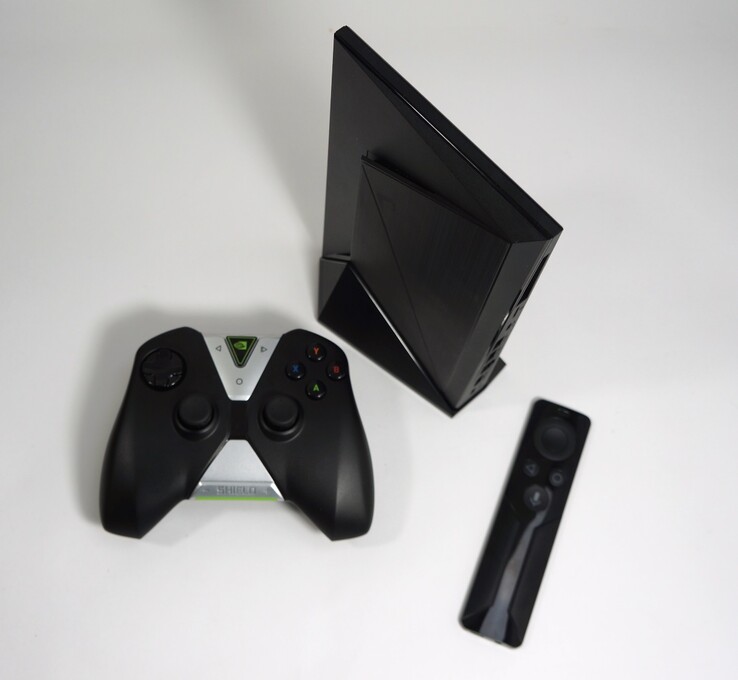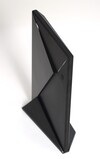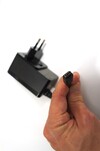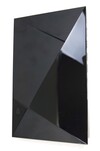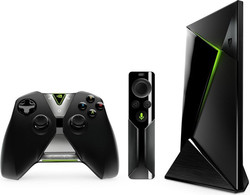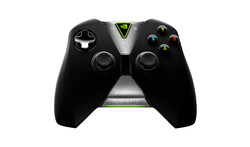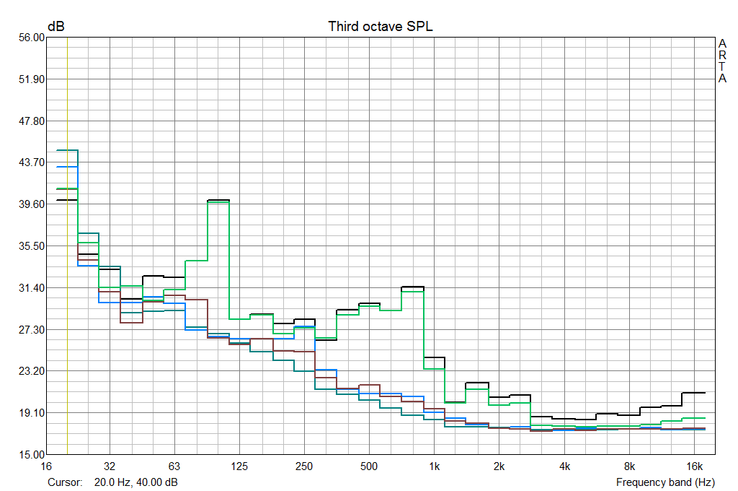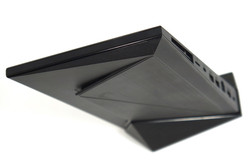Nvidia Shield Android TV Review
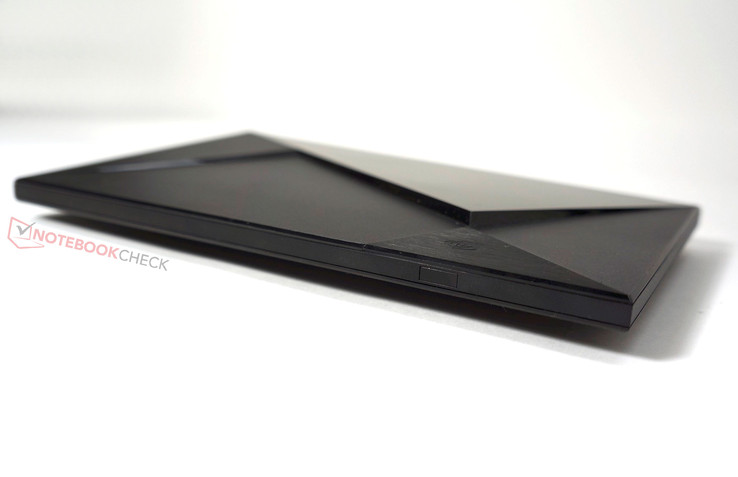
According to Nvidia themselves, their Shield TV is currently the best Android TV box on the market. Since the device supports 4K streaming, Android gaming, GeForce NOW game streaming from the server as well as game streaming from the home PC (with Nvidia GPU), the claim might not be unsubstantiated. We take a look at the current version with Android 6.0 and subject the small black box to some of our tests and benchmarks.
Case
The small, stylish little box integrates well into a user's home TV environment. The chassis looks quite nice thanks to the polygon-like design elements, although the high-gloss surface areas scratch easily. The optional sturdy aluminum stand allows the console to be positioned upright - but the price of 35 Euro (~$40) for the stand with a "nano-suction base" seems quite excessive.
It takes a while to locate the capacitive power switch on the top (area with the Nvidia logo) at first; once the console is turned on, the switch is illuminated from the inside. The brightness is configurable, which is a nice touch.
Connectivity
The back of the console houses all cabled ports and connections. Interestingly enough, Nvidia decided on a proprietary power connector (similar to USB C and reversible as well). The HDMI port supports HDMI 2.0 and thus 4K video at 60 Hz. We should also mention the two USB 3.0 ports, which can not only charge the controller or the remote, but also allow for storage expansion via external hard drives or USB flash drives.
Software
Our review console came loaded with Android 6.0 Marshmallow. The OS is designed to be used for Android TV and therefore lacks some of the functionality we are used to from smartphones and tablets. The launcher, task manager (only rudimentary access with a USB keyboard is possible) and the Play Store are all pared down from their respective full version.
A plus point is the support of Google Cast. We had no issues sending photos and videos from our Android smartphone to the console and our TV, respectively.
Communication and GPS
The integrated 802.11ac WLAN module achieved lower-than-average transfer rates. Connected to our Linksys EA8500, Nvidia's Shield TV managed a connection speed of about 273 Mbit/s (distance of 1 m). The average at the time of writing is about 320 Mbit/s. The connection was very stable, however and we had no issues using GeForce NOW over Wifi one floor below the router.
The Gigabit LAN reached transfer rates 555 MBit/s, which is also lower than expected with the typical speeds normally in the neighborhood of 950 MBit/s.
Accessories and Warranty
Input Devices and Operation
The included controller is identical to the one Nvidia sold as an accessory for their Shield Tablet. Please check our reviews (Shield Tablet and Shield Tablet LTE) for details. The only difference is the labeling of the home button. The haptic characteristics haven't changed at all, so all things considered, this is a good, but not outstanding controller. The Wifi Direct connection between the controller and the console worked well and remained stable during the review period. Sound was also transferred to the controller without any issues.
Performance
The Nvidia Shield Android TV features high-end hardware components. The Tegra Y1 SoC is also used by Google for their Pixel C Tablet and houses the currently fasted ARM-based GPU on the market. The performance of the eight ARM CPU cores is also very decent, albeit not quite as class-leading as the GPU performance. Four Cortex A53 cores are designated battery-saver cores, while four Cortex A57 cores deliver the performance. For more information, please check our specialty page for the Tegra X1. The powerful SoC can access a generous compliment of 3 GB LPDDR4 RAM.
| AnTuTu v6 - Total Score | |
| NVIDIA Shield Android TV | |
| HTC 10 | |
| Samsung Galaxy S7 Edge | |
| Huawei P9 | |
| Google Pixel C | |
| Google Nexus 6P | |
| Geekbench 3 | |
| 64 Bit Single-Core Score | |
| HTC 10 | |
| Samsung Galaxy S7 Edge | |
| Google Nexus 9 | |
| Huawei P9 | |
| NVIDIA Shield Android TV | |
| Google Pixel C | |
| Google Nexus 6P | |
| 64 Bit Multi-Core Score | |
| Huawei P9 | |
| Samsung Galaxy S7 Edge | |
| HTC 10 | |
| Google Nexus 6P | |
| NVIDIA Shield Android TV | |
| Google Pixel C | |
| Google Nexus 9 | |
| 3DMark | |
| 1280x720 offscreen Ice Storm Unlimited Score | |
| NVIDIA Shield Android TV | |
| Google Pixel C | |
| Samsung Galaxy S7 Edge | |
| HTC 10 | |
| Google Nexus 6P | |
| Google Nexus 9 | |
| Huawei P9 | |
| 1280x720 offscreen Ice Storm Unlimited Graphics Score | |
| NVIDIA Shield Android TV | |
| Google Pixel C | |
| Google Nexus 9 | |
| Google Nexus 6P | |
| Samsung Galaxy S7 Edge | |
| HTC 10 | |
| Huawei P9 | |
| 1280x720 offscreen Ice Storm Unlimited Physics | |
| NVIDIA Shield Android TV | |
| Google Pixel C | |
| HTC 10 | |
| Samsung Galaxy S7 Edge | |
| Huawei P9 | |
| Google Nexus 6P | |
| Google Nexus 9 | |
| 2560x1440 Sling Shot OpenGL ES 3.0 | |
| NVIDIA Shield Android TV | |
| HTC 10 | |
| Google Pixel C | |
| Samsung Galaxy S7 Edge | |
| Google Nexus 6P | |
| Huawei P9 | |
| 2560x1440 Sling Shot OpenGL ES 3.0 Graphics | |
| NVIDIA Shield Android TV | |
| HTC 10 | |
| Google Pixel C | |
| Samsung Galaxy S7 Edge | |
| Google Nexus 6P | |
| Huawei P9 | |
| 2560x1440 Sling Shot OpenGL ES 3.0 Physics | |
| Huawei P9 | |
| NVIDIA Shield Android TV | |
| Samsung Galaxy S7 Edge | |
| HTC 10 | |
| Google Pixel C | |
| Google Nexus 6P | |
| GFXBench (DX / GLBenchmark) 2.7 | |
| T-Rex Onscreen | |
| NVIDIA Shield Android TV | |
| Samsung Galaxy S7 Edge | |
| Google Nexus 9 | |
| Huawei P9 | |
| HTC 10 | |
| Google Pixel C | |
| Google Nexus 6P | |
| 1920x1080 T-Rex Offscreen | |
| NVIDIA Shield Android TV | |
| Samsung Galaxy S7 Edge | |
| HTC 10 | |
| Google Pixel C | |
| Google Nexus 9 | |
| Google Nexus 6P | |
| Huawei P9 | |
| GFXBench 3.0 | |
| on screen Manhattan Onscreen OGL | |
| NVIDIA Shield Android TV | |
| Samsung Galaxy S7 Edge | |
| HTC 10 | |
| Google Nexus 9 | |
| Google Pixel C | |
| Huawei P9 | |
| Google Nexus 6P | |
| 1920x1080 1080p Manhattan Offscreen | |
| NVIDIA Shield Android TV | |
| Google Pixel C | |
| HTC 10 | |
| Samsung Galaxy S7 Edge | |
| Google Nexus 9 | |
| Google Nexus 6P | |
| Huawei P9 | |
| GFXBench 3.1 | |
| on screen Manhattan ES 3.1 Onscreen | |
| NVIDIA Shield Android TV | |
| Samsung Galaxy S7 Edge | |
| HTC 10 | |
| Google Pixel C | |
| Huawei P9 | |
| Google Nexus 6P | |
| 1920x1080 Manhattan ES 3.1 Offscreen | |
| NVIDIA Shield Android TV | |
| Google Pixel C | |
| Samsung Galaxy S7 Edge | |
| HTC 10 | |
| Google Nexus 6P | |
| Huawei P9 | |
| PCMark for Android - Work performance score | |
| NVIDIA Shield Android TV | |
| Huawei P9 | |
| Google Pixel C | |
| Google Nexus 9 | |
| HTC 10 | |
| NVIDIA Shield Tablet LTE P1761 | |
| Google Nexus 6P | |
| Samsung Galaxy S7 Edge | |
Gaming
The Tegra X1 of course has absolutely no issues handling Android games. Thanks to the most powerful GPU in the Android-realm, all of the games available for download in the Play Store run smoothly.
Game Streaming
As we mentioned earlier, Nvidia's streaming technology works very well. GeForce NOW does requires a fast Internet connection, however. During our test, games which can handle a little input lag - for example, Lego games - worked as they should
Video Playback
The Shield Android TV box really is in its element when playing movies and videos. In conjunction with Kodi, the device can even handle H.265/HVEC Video at a 4K resolution. We did run into issues with a 10-bit 4K 60 Hz H.265 test clip, however. The culprit could be Kodi media player. 10-bit support has been announced already, so the hardware should be able to handle it.
Video streaming via Youtube and Netflix worked flawlessly as well. Both sources support 4K playback already.
Nvidia's home entertainment console seems to be well-suited for video fans. The only real point of criticism mentioned in some forums is the lack of an automatic switching mechanism for 24 fps material should it be encountered. As of now, the user needs to venture into the Android settings to make the change.
Emissions
Temperature
The temperatures of the small console remain uncritical at all times. During idle, the chassis is always cool to the touch and even under continuous load, the recorded temperatures remain very low.
System Noise
The integrated fan is inaudible more than a few cm away from the console and thus never really comes into play. At a distance of 15 cm (~6 inches), the noise level was only 0.1 dB above ambient. Our microphone was only able to record the fan characteristics within a couple of cm from the chassis. Without load, the fan didn't spin at all - or so slowly, that it was essentially noiseless.
(+) The maximum temperature on the upper side is 35 °C / 95 F, compared to the average of 33.9 °C / 93 F, ranging from 25 to 47 °C for the class Desktop.
(+) The bottom heats up to a maximum of 28 °C / 82 F, compared to the average of 33.6 °C / 92 F
(+) In idle usage, the average temperature for the upper side is 26.2 °C / 79 F, compared to the device average of 29.5 °C / 85 F.
Speakers
The console doesn't feature a dedicated audio-out port, so only the HDMI port can transfer digital sound signals to a TV or a receiver. The controller as well as the remote come with a 3.5 mm audio jack, which transmitted clear audio without parasitic noise when we tested the output with an AKG GHS 1 headset.
Power Consumption
Thanks to the tablet SoC, the console's power consumption is well controlled. We measured a peak draw of 17 watts; the average under load is about 10 watts. Navigating the start menu requires 4 to 5 watts. The power consumption is negligible when the Nvidia Shield is turned off, but the device requires 2.8 watts during standby (up to 3.3 watts if the fan is still spinning), which is far from praiseworthy. The power adapter can supply up to 40 watts and is thus sized appropriately for the task at hand.
| Off / Standby | |
| Idle | |
| Load |
|
Key:
min: | |
Pros
Cons
Verdict
Is the Shield TV the best Android TV box available at this time? We didn't really find anything to dispute this claim. In addition to the superb performance of the Tegra-X1-SoC and the very decent video support, the streaming features are a definite value-add. What remains as a negative is a significantly higher price compared to the competition - for example the Amazon Fire TV 4K, which sells for 99 Euro (in the US the price is $99). The Shield Android TV hardly has any weaknesses according to our tests, however. The WLAN connection could be faster, the controller a little higher-end (which in turn would likely raise the price) - and there are a few Android TV limitations which are frankly a little annoying. Positive aspects on the other hand are the high SoC performance, the comprehensive video support, and the low emissions. Since the release, the content offering has increased significantly, but GeForce NOW could certainly use a few more bockbuster titles. The Play Store for Android TV could also use additional content. Games like Stikbold! (dodge ball) or apps like YouTV (online video recorder) really show the console's and the platform's potential.




